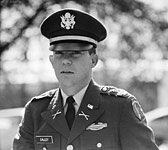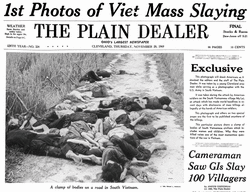The Cover Up

Colonel Henderson
The attack was quickly covered up, and the cover story was that 128 Viet Cong soldiers were killed and three weapons were captured. In reality, only one American soldier was injured because shot himself in the foot, and about 500 villagers were killed. (15) It is believed that the Viet Cong returned the night of the massacre and buried the bodies. Mass graves were built for these people.
The lies regarding the number of civilians killed were easily believed, and through the press it was deemed a significant American victory.
A man named Colonel Henderson was ordered to investigate this case, but he deliberately helped to cover it up. He interviewed only a few soldiers and declared that about only 20 villagers were mistakenly killed, even though he had personally seen hundreds of bodies.
While this was all happening, a Charlie Company GI named Micheal Bernhart, was extremely bothered from what he had seen at My Lai, and wanted to send a letter to his congressman about what really did happen. After learning about this, Medina confronted Bernhart and told him that it would be very unwise for him to follow through with his plan. Many other soldiers who wanted to speak out against the army’s actions were also told to keep quiet.
The lies regarding the number of civilians killed were easily believed, and through the press it was deemed a significant American victory.
A man named Colonel Henderson was ordered to investigate this case, but he deliberately helped to cover it up. He interviewed only a few soldiers and declared that about only 20 villagers were mistakenly killed, even though he had personally seen hundreds of bodies.
While this was all happening, a Charlie Company GI named Micheal Bernhart, was extremely bothered from what he had seen at My Lai, and wanted to send a letter to his congressman about what really did happen. After learning about this, Medina confronted Bernhart and told him that it would be very unwise for him to follow through with his plan. Many other soldiers who wanted to speak out against the army’s actions were also told to keep quiet.
Demands of Justice

Ronald Ridenhour, a soldier in the American Army, had heard five eyewitness accounts of the My Lai Massacre. He sent a letter to President Nixon, the Pentagon, the State Department, the Joint Chiefs of Staff, and many members of congress in which he demanded to know what really occured in My Lai. In his letter he proclaimed, "I remain irrevocably persuaded that if you and I do truly believe in the principles, of justice and the equality of every man, however humble, before the law, that form the very backbone that this country is founded on, then we must press forward a widespread and public investigation of this matter with all our combined efforts." (16) Many receivers of this letter simply ignored Ridenhour's requests for the truth, but Representative Morris Udall did not. He insisted upon having a full investigation of what Ridenhour had to say.
In April of 1969, General Westmoreland had the case go to the inspector general for investigation. In August, the investigation was being led by the army’s Criminal Investigation Division to decide whether or not criminal charges would be filed against Calley and other participants.
Seymour Hersh was the first reporter to publish details of the My Lai killings on November 12, 1969. In his articles he informed citizens of the details of the massacre. He included eye-opening quotes from interviews he conducted with three American soldiers who were present during the massacre. In his article Hersh quoted Sergeant Michael Bernhard when he stated, “The whole thing was so deliberate. It was point-blank murder and I was standing there watching it.” (17) As a result of his work, Hersh received the Pulitzer Prize for international reporting. His articles fueled the peace movement and reduced public support for the war.
In April of 1969, General Westmoreland had the case go to the inspector general for investigation. In August, the investigation was being led by the army’s Criminal Investigation Division to decide whether or not criminal charges would be filed against Calley and other participants.
Seymour Hersh was the first reporter to publish details of the My Lai killings on November 12, 1969. In his articles he informed citizens of the details of the massacre. He included eye-opening quotes from interviews he conducted with three American soldiers who were present during the massacre. In his article Hersh quoted Sergeant Michael Bernhard when he stated, “The whole thing was so deliberate. It was point-blank murder and I was standing there watching it.” (17) As a result of his work, Hersh received the Pulitzer Prize for international reporting. His articles fueled the peace movement and reduced public support for the war.
